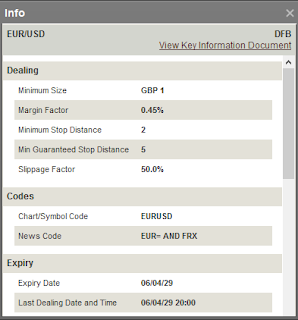Reading Time - 8 Minutes
It is one of the words that every trader has come across at
some point. However, very few actually understand what it is or how it works.
In this blog post I am going to look at specifically the new rules on leverage
proposed by ESMA (European Securities and Markets Authority). We will look at the differences the changes will make and
also show who it will hit hardest.
I am sure if you are with a broker anywhere in Europe, you
have received somewhat panic-stricken emails from the broker, urging you to
email ESMA and show your opposition to the new leverage restrictions they are
suggesting. Your broker isn’t doing that because they care about you and want you
to always have the best they can offer – they are emailing you because the new
regulations would cost the brokers money in loss of business.
So, the first thing to say is that I would be VERY surprised
if the new regulations don’t come into force. The EU write their own rules with
very little care for the opinion outside of their bureaucracy. Sometimes I
think their departments make new regulations simply to justify their jobs… can
you spot my disdain for them yet?
However, there does need to be a change within the trading
industry. You can get leverage as high as 1:200, which is frankly ridiculous.
What it does is inspire gambling and leads to a lot of beginners losing a lot
of money. It is easy to quick-fire orders on a market when you are in a downward
spiral of emotional trading, and with such high leverage, your broker will only
margin call your account when it is almost completely cleaned out.
The brokers themselves do not care, and so it had to come to
some regulatory board to bring about changes. I do think as an adult, you
should shoulder the full responsibility of your decisions and be able to MAKE
those decisions without big-brother looking over your shoulder. You risked the
money. You lost the money. It is your own fault. But the changes are almost
certainly coming, and there will actually be some benefits and safeguards that
it will bring about.
So, who is this going to hurt and who isn’t it going to
hurt?
 Mainly it is going to hurt those with small trading
accounts. It is going to force you to reduce your risk on trades, like it or
not. It may even price some people out of the markets… But, is that a bad
thing? If you are risking extremely high amounts in terms of a percentage of
your overall account, you are going to blow your account anyway. It happens
every single time. If you are looking to build a career or a serious secondary
income source, you need to use strict money management. The new leverage rules
will force you to be somewhat safer with your money.
Mainly it is going to hurt those with small trading
accounts. It is going to force you to reduce your risk on trades, like it or
not. It may even price some people out of the markets… But, is that a bad
thing? If you are risking extremely high amounts in terms of a percentage of
your overall account, you are going to blow your account anyway. It happens
every single time. If you are looking to build a career or a serious secondary
income source, you need to use strict money management. The new leverage rules
will force you to be somewhat safer with your money.
What about those who can’t afford to open an account and
trade with the new leverage levels? Again, is that really that bad? If you
can’t afford to put say a couple of thousand in an account, should you even be
trading? People may get outraged but being able to trade at 1:200 is crazy. It
will force people onto a demo account until they can build money enough to open
a live account. In that time, people can learn whilst safe from blowing a real
account.
It is also going to hurt swing traders or anyone who has
multiple positions open at once. Trying to hold 5 – 10 positions at once will
require a much larger account to cover the margin requirements. We are going to
look at some examples shortly.
Who isn’t it going to hurt as much? Well, us day traders who
use good money-management. If you are risking small amounts of your capital,
say 1% - 3% then the new leverage will not have such a profound impact. As a
day trader, I only ever have 1 position open at a time, and on very rare
occasions, two. Again, that protects me from the new changes. But really, it
protects me from huge losses, which is the real reason I do it, and the real
reason all professionals do it.
Let’s look at a couple of examples on the FTSE 100 and
EURUSD using IG Index broker. Currently, they offer up to 1:200 leverage.
However, with the new proposals, major markets may drop down to 1:30.
The amounts we will use can be reduced slightly by using
tight stops, but for the purpose of this blog we will just use the standard
margin requirements for the positions.
FTSE 100 EXAMPLES
Let’s look at two FTSE 100 examples. We will say you want to
open a position risking £10 per point (spread betting) or one contract (CFD).
For our second example we will look at a position risking £2 per point (spread
betting) or one mini-contract (CFD).
The simplified sum we use is:
Risk X Current Market Level X Margin Factor
So for the FTSE 100 examples:
10 X 7220 (around the current level on 20th Feb)
X 0.9% (Your broker will display their margin factor for each market)
= £649.80
That is what needs to be in your account to cover the trade
– basically it is what your broker uses as a deposit to secure the use of the
leverage. If you took another trade at the exact same level with the same risk,
you would then need £1,299.60 etc.
Our second example would be:
2 X 7220 X 0.9% = £129.96
It is important to note here also, that these totals are not
your risk when calculating say your 1% risk for entering a trade. Just because
my margin is £129.96, does not mean that I am not planning on exiting at a
minus £40 loss, which would be a 1% risk on a £4,000 account. If my stop is set
at the £40 loss level, my risk is £40, not the margin amount.
Now let’s do the math on the same position on EUR/USD which
has a margin factor of 0.45%
EURUSD EXAMPLES
10 X 13,345 (around the current level on 20th
Feb) X 0.45% = £600.53
2 X 13,345 X 0.45% = £120.10
So, what we can see, is that currently you really don’t need
a lot of money to open positions. But what most people see is the ability to
make much larger returns in terms of their investment. The other side of the
coin is that the losses can also happen very quickly. You can be risking huge
portions of your account on trades and within a matter of minutes be left with
nothing. The gambling warnings that every broker displays are not there
randomly. They are there because a very high portion of people gamble their
money away very very quickly in trading.
Let’s now look at the same examples, but with a new 1:30
leverage limit that is likely going to come into force. That will equate to
roughly 3.33%.
FTSE 100 EXAMPLES
10 X 7220 X 3.33% = £2,404.26
2 X 7220 X 3.33% = £480.52
So, now we have much bigger numbers. But, as long as you are
following good money management, the changes really shouldn’t scare you at all.
Especially not if you are a day trader. What it will also do, is FORCE people
to use much better money management and keep people who can’t afford to lose
the money off of the charts. I must stress here, I in NO WAY agree with the
changes and think adults should make their own free choices. However, you have
to take into account the positives. If you had heard as many horror stories as
I have of people losing their pensions and life-savings, you would understand
where I am coming from. Sometimes safety nets DO help.
If we look at the widely accepted ‘safe’ level of money
management, it suggests only ever risking 1% of your account on any one trade.
Now let’s say at £10 per point on the FTSE 100 you are
risking 12 points – which is an average sized stop for me day trading. We will
also use this example for the £2 per point risk.
That means you are risking £120, which means you should have
a £12,000 account. For the second example you are risking £24 and should have a
£2,400 account.
As you can see, neither of these are hampered by the new
leverage proposals. You would need to either be in 5 trades at once, or risking
way too high in proportion to your trading account for it to start impacting
you. This is where it may hurt swing traders. If you usually have 5 – 10
positions open at once, that is going to become very difficult to do without
reducing risk drastically.
For EURUSD, using the same examples but with a similar 12-point
stop –
EURUSD EXAMPLES
10 X 13,345 X 3.33% = £4,443.89
2 X 13,345 X 3.33% = £888.78
Your risk is exactly the same in both examples, and again
the new leverage regulations do not hamper your trading. Even after multiple
losses in a row, you STILL have the ability to trade at your 1% risk without
adjustments. Even if you are risking 2% per trade, it does not hurt your
trading approach.
 So, the likelihood is that the new leverage regulations WILL
come into force. I do not in any way expect the emails of us retail traders to
change the proposals. However, it isn’t something you should fear as a trader
on the worry that it will snuff you out of doing something you enjoy. For us
day traders certainly, and those using good money management, we will be able
to continue as normal. It will also force beginners to use better money
management which is no bad thing.
So, the likelihood is that the new leverage regulations WILL
come into force. I do not in any way expect the emails of us retail traders to
change the proposals. However, it isn’t something you should fear as a trader
on the worry that it will snuff you out of doing something you enjoy. For us
day traders certainly, and those using good money management, we will be able
to continue as normal. It will also force beginners to use better money
management which is no bad thing.
I hope you’ve all had a great trading week!











